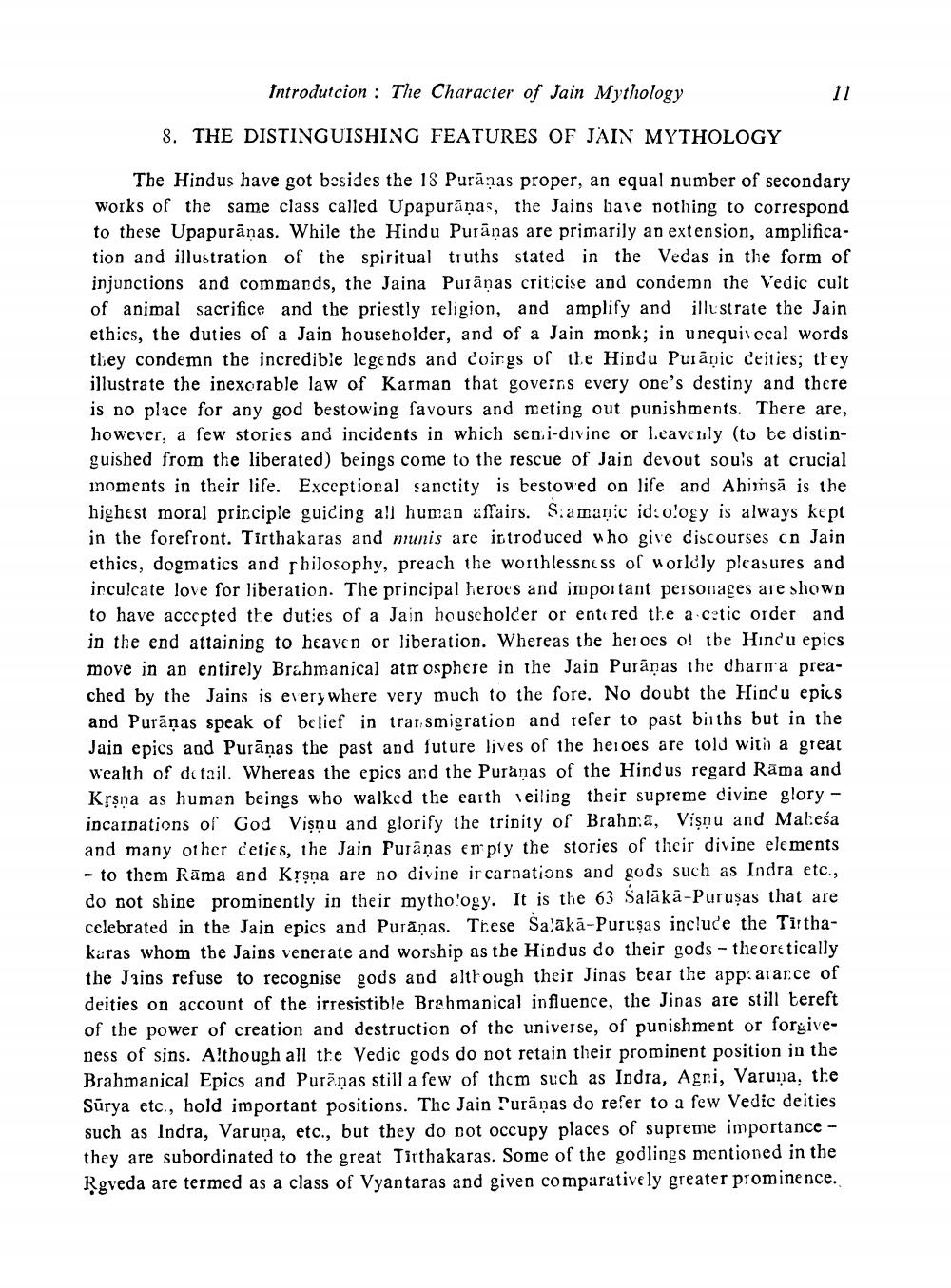________________
Introdutcion : The Character of Jain Mythology
8. THE DISTINGUISHING FEATURES OF JAIN MYTHOLOGY
The Hindus have got besides the 18 Purānas proper, an equal number of secondary works of the same class called Upapurāņas, the Jains bave nothing to correspond to these Upapurānas. While the Hindu Purāņas are primarily an extension, amplification and illustration of the spiritual truths stated in the Vedas in the form of injunctions and commards, the Jaina Purāṇas criticise and condemn the Vedic cult of animal sacrifice and the priestly religion, and amplify and illustrate the Jain ethics, the duties of a Jain householder, and of a Jain monk; in unequivocal words they condemn the incredible legends and coirgs of the Hindu Putānic deities; they illustrate the inexorable law of Karman that governs every one's destiny and there is no place for any god bestowing favours and meting out punishments. There are, however, a few stories and incidents in which sen. i-divine or Leavenly (to be distinguished from the liberated) beings come to the rescue of Jain devout souls at crucial moments in their life. Exceptional sanctity is bestowed on life and Ahimsa is the highest moral principle guiding all human affairs. Siamanic id: ology is always kept in the forefront. Tirthakaras and munis are introduced who give discourses on Jain ethics, dogmatics and shilosophy, preach the worthlessness of worldly pleasures and inculcate love for liberation. The principal heroes and important personages are shown to have accepted the duties of a Jain householder or entered the a cetic order and in the end attaining to heaven or liberation. Whereas the heroes o! the Hind'u epics move in an entirely Brahmanical atmosphere in the Jain Purāņas the dharna preached by the Jains is everywhere very much to the fore. No doubt the Hindu epics and Purāņas speak of belief in transmigration and refer to past births but in the Jain epics and Purāņas the past and future lives of the heroes are told with a great wealth of detail. Whereas the epics and the Puranas of the Hindus regard Räma and Kysa as human beings who walked the earth eiling their supreme divine glory - incarnations of God Vişnu and glorify the trinity of Brahn:ā, Vişnu and Mahesa and many other cetjes, the Jain Purānas en ply the stories of their divine elements - to them Rāma and Krsna are no divine ir carnations and gods such as Indra etc., do not shine prominently in their mythology. It is the 63 Salākā-Puruşas that are celebrated in the Jain epics and Purāņas. Trese Salākā-Puruşas include the Tirthakaras whom the Jains venerate and worship as the Hindus do their gods - theoretically the Jains refuse to recognise gods and although their Jinas bear the app atar.ce of deities on account of the irresistible Brabmanical influence, the Jinas are still tereft of the power of creation and destruction of the universe, of punishment or forgiveness of sins. Although all the Vedic gods do not retain their prominent position in the Brahmanical Epics and Puranas still a few of them such as Indra, Agni, Varuna, the Sūrya etc., hold important positions. The Jain urānas do refer to a few Vedic deities such as Indra, Varuna, etc., but they do not occupy places of supreme importance - they are subordinated to the great Tirthakaras. Some of the godlings mentioned in the Rgveda are termed as a class of Vyantaras and given comparatively greater prominence.




